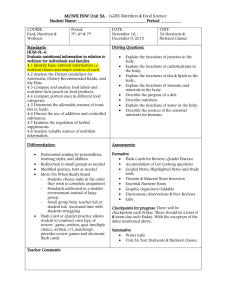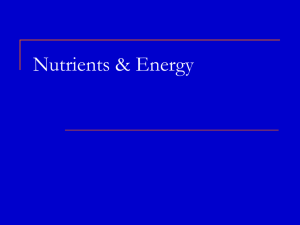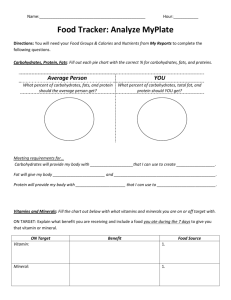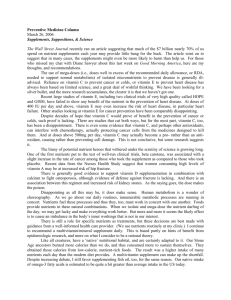Health Semester Review
advertisement
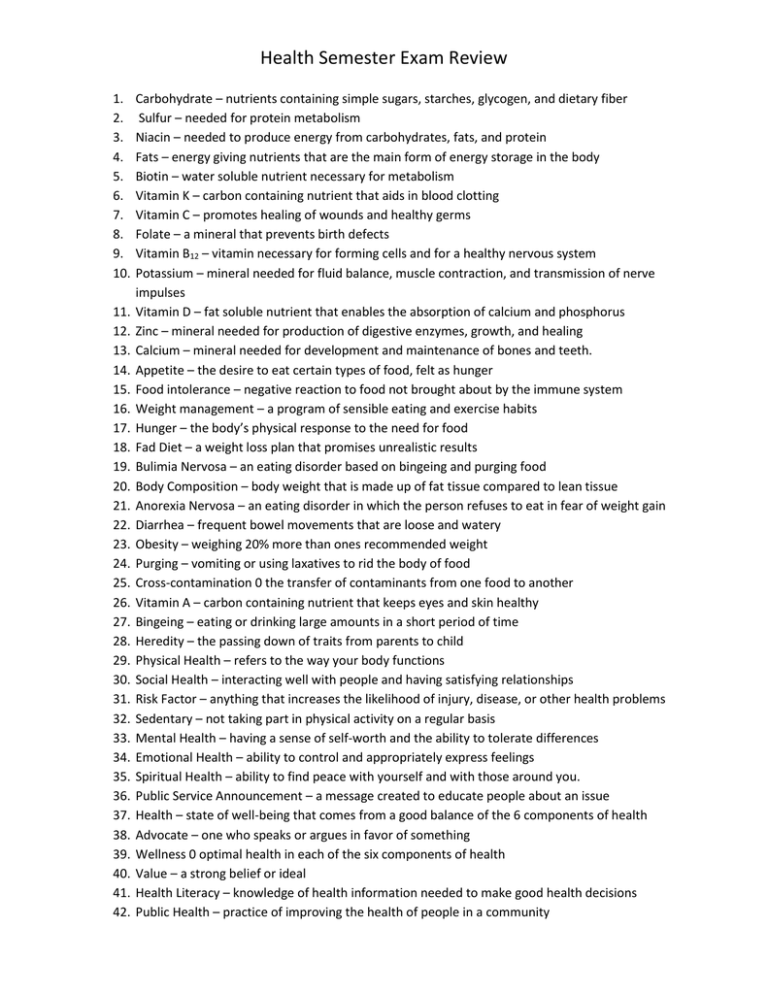
Health Semester Exam Review 1. 2. 3. 4. 5. 6. 7. 8. 9. 10. 11. 12. 13. 14. 15. 16. 17. 18. 19. 20. 21. 22. 23. 24. 25. 26. 27. 28. 29. 30. 31. 32. 33. 34. 35. 36. 37. 38. 39. 40. 41. 42. Carbohydrate – nutrients containing simple sugars, starches, glycogen, and dietary fiber Sulfur – needed for protein metabolism Niacin – needed to produce energy from carbohydrates, fats, and protein Fats – energy giving nutrients that are the main form of energy storage in the body Biotin – water soluble nutrient necessary for metabolism Vitamin K – carbon containing nutrient that aids in blood clotting Vitamin C – promotes healing of wounds and healthy germs Folate – a mineral that prevents birth defects Vitamin B12 – vitamin necessary for forming cells and for a healthy nervous system Potassium – mineral needed for fluid balance, muscle contraction, and transmission of nerve impulses Vitamin D – fat soluble nutrient that enables the absorption of calcium and phosphorus Zinc – mineral needed for production of digestive enzymes, growth, and healing Calcium – mineral needed for development and maintenance of bones and teeth. Appetite – the desire to eat certain types of food, felt as hunger Food intolerance – negative reaction to food not brought about by the immune system Weight management – a program of sensible eating and exercise habits Hunger – the body’s physical response to the need for food Fad Diet – a weight loss plan that promises unrealistic results Bulimia Nervosa – an eating disorder based on bingeing and purging food Body Composition – body weight that is made up of fat tissue compared to lean tissue Anorexia Nervosa – an eating disorder in which the person refuses to eat in fear of weight gain Diarrhea – frequent bowel movements that are loose and watery Obesity – weighing 20% more than ones recommended weight Purging – vomiting or using laxatives to rid the body of food Cross-contamination 0 the transfer of contaminants from one food to another Vitamin A – carbon containing nutrient that keeps eyes and skin healthy Bingeing – eating or drinking large amounts in a short period of time Heredity – the passing down of traits from parents to child Physical Health – refers to the way your body functions Social Health – interacting well with people and having satisfying relationships Risk Factor – anything that increases the likelihood of injury, disease, or other health problems Sedentary – not taking part in physical activity on a regular basis Mental Health – having a sense of self-worth and the ability to tolerate differences Emotional Health – ability to control and appropriately express feelings Spiritual Health – ability to find peace with yourself and with those around you. Public Service Announcement – a message created to educate people about an issue Health – state of well-being that comes from a good balance of the 6 components of health Advocate – one who speaks or argues in favor of something Wellness 0 optimal health in each of the six components of health Value – a strong belief or ideal Health Literacy – knowledge of health information needed to make good health decisions Public Health – practice of improving the health of people in a community Health Semester Exam Review 43. 44. 45. 46. 47. 48. 49. 50. 51. 52. 53. 54. 55. 56. 57. 58. 59. 60. 61. 62. 63. 64. 65. 66. 67. 68. 69. 70. 71. 72. 73. 74. 75. 76. 77. 78. 79. 80. Psychologist – a person who studies emotions and behaviors “I” Message – a good technique for communicating assertively Accepting Yourself – an important way to imrpove self-esteem Defense Mechanism – unconscious behavior used to protect oneself from unpleasant emotions Emotions – feelings in response to an activity or an experience Self – Talk – saying things to yourself Aggressive Communication – hostile and unfriendly in expression Major Depressive Disorder – also known as “Depression” Passive Communication – offering no opposition to challenges or pressure Self – Concept – a measure of how you view yourself Nutrition – the study of food and ways in which the body uses food Nutrient Density – measure of nutrients in food compared with the energy a food provides Dietary Fiber – complex carbs that aids in body elimination and help heart diesease and cancer Recommended Dietary Allowance (RDA) – recommended nutrients that meet our needs as healthy people Minerals – nutrients that are needed for enzyme process and bone formation Water – transports, eliminates, and temperature regulation, as well as other bodily functions Carbs, Fats, Proteings, Water, Minerals, and Vitamins – the 6 classes of nutrients No Dairy Source of Calcium – dark-green, leafy vegetables, tofu, and bony fish Healthful Meals & Healthful Snacks – foods that meed our needs and maintain a healthy weight Unsaturated Fatty Acids – the carbon atoms do not hold the maximum number of hydrogen atoms Calorie – a unit of food energy measurement Incomplete Protein – foods that are missing some essential amino acids Food Guide Pyramid – a tool for choosing a healthy diet by selecting the number of servings from each of the 6 food groups Vegetarian – dietary pattern that includes few or no animal products Proteins – class of nutrients consisting of long chains of amino acids which help to build and repair Anemia – decrease in red blood cells Dementia – decrease in brain function, memory loss and personality changes Alcohol – the drug in beer, wine, and liquor that causes intoxication DUI – driving under the influence Al-Anon – helps the family spouse, and friends of an alcoholic Hangover – physical effects caused by excessive alcohol use COPD – Chronic Obstructive Pulmonary Disease Snuff – finely ground smokeless tobacco Addictive – substance that causes physical dependence Smokeless Tobacco – tobacco that is not smoked Herbal Cigarette – cigarette that contains tobacco and a spice that makes them tast better Chewing Tobacco - tobacco that is placed between a person’s cheek and gum Club Drugs – PCP, Ketamine, or GHB – designed to closely resemble common illegal drugs

